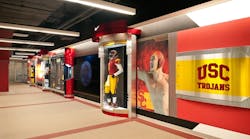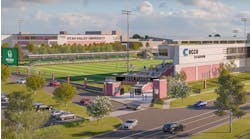Athletic facilities designed to help them win the best recruits are also leading to higher donations.
A new twist on traditional design known as immersion branding goes beyond the usual approach of logos, trophies and team colors to put the soul of a school into a building, amplifying its unique story. This clear presentation of story is adding value that can be measured in increased donations from alumni, funding both the immersive branding, as well as additional improvements or extensions to the facilities themselves.
Why do it
Blank walls are a lost opportunity to make an impression on 17-year-old recruits. New athletic facilities typically cost between $10 million and $70 million, yet at ribbon cuttings they often don’t look that much different from the facility down the road.
Any “latest and greatest” advantage can be lost as soon as another school announces plans for its new facility. Although the facility will functionally serve its purpose for 20 to 30 years, the recruiting value of “new” drops like a roller coaster, with similar stomach-churning effects on administrators.
To deal with this challenge, administrators have been changing their approach to recruiting. This emerging approach can be summarized as the “Three Ds” of facility branding: differentiation, design and Disney:
•Differentiation. Even though “different” is the root of differentiation, most athletic facilities are not unique. Based on the trophy cases, lists of names and team photos that inhabit most of them, it would be easy to assume that the only differences between schools are team colors and mascots.
True differentiation immerses visitors in the stories and culture of the school, so recruits can imagine themselves being a part of it.
•Design. Design probably would not be on the top 10 list of any recruit’s stated reasons for choosing a school. However, this generation of students has had more exposure to the influence of design than any previous generation, and it has a powerful unconscious effect on their choices.
Previous generations chose based on functional differences, and design was an afterthought. This generation chooses between functionally similar products based on which has the better design.
This change can be seen in the rise of companies such as Apple and Beats Audio. Although other products perform similar functions (and cost less), they often are bypassed for the product with the better design.
•Disney. One administrator notably stated that he wasn’t just competing with other colleges for the attention of recruits, but that he was also competing with the best experiences of their lives. Disney has set a high bar for immersive experiences and is the standard these leading-edge administrators are aiming for.
Colleges leading this new wave are creating immersive experiences as part of the plan for their facilities. These experiences use video, audio, interactive and tactile exhibits to put recruits into the story of the school. If a recruit is going to look at multiple schools with similar opportunities for success, the most memorable gets an edge.
Fund Raising
Development teams see an opportunity to use immersive branding programs to create excitement that generates donor engagement.
The same stories and exhibits that are so memorable for a prospect also connect more deeply with fans, alumni and donors. It’s easier to get donors excited about an innovative exhibit (with their names on it) than it is to get them engaged with the mechanical plans for the HVAC system. That excitement can lead to bigger checks.
How to do it
An immersive branding project typically adds 6 to 10 percent to the overall budget of new construction. Many of these projects begin with conceptual design of the immersive exhibits before the details of the building are defined.
The immersive brand design team is separate from the architects and interior designers. It’s important for these three teams to coordinate their efforts early on.
For example, the exhibits often need to be recessed in walls, and they may have special electrical or data needs. Also, the finish details of the exhibits should be coordinated with the color palettes, furnishings and finishes that the interior designer is using throughout the building. By working together from the start, institutions can minimize change orders.
The brand design team needs access to images, video and stories that feed the content of the exhibits. Getting the details of the exhibits right takes more time from the administrative team than typical interior design choices, but making the investment leads to side benefits in better content for other media outlets.
Like a museum, extra time must be allowed after construction so the immersive exhibits can be installed and configured. This can take from two to six weeks, depending on the complexity of the exhibits.
Austin is the president of Advent, an experience-design firm based in Nashville, Tenn.


